Photos: Kip Miller
We have just returned from a three-day panegýri (a saint's day festival) in a tiny village in Epirus. The contrast between the wild beauty of Greece's mountains and the urban landscape in front of us couldn't be more pronounced. We drag our suitcases into the cool of the hotel lobby. "It's time to plan our remaining time in Greece, but it can't be in Athens," says my husband, drops of sweat streaking his face. "For sure," I agree. "Let's recoup for half an hour and then head over to the Olympic Airways office across the square."
The ticket line is longer than one would expect during the lunch hour. We take our place behind a dozen locals waiting to book their own escape flights. Finally, it's our turn. "When is the next plane leaving for a Greek island?" asks my husband. "Which island do you want to go to?" queries the girl behind the ticket window. "Any island," he replies. She suppresses a chuckle. "The next flight out of Athens leaves for Kýthera in an hour and a half," she announces. "We'll take it," my husband sighs in relief. Our taxi moves quickly through the city's siesta-quiet streets, arriving in record time at Ellinikón Airport, just beyond the popular Glyfáda suburb. We rush to the gate for Kýthera where a miniscule plane awaits. "You've got to be kidding!" I exclaim as I eyeball the tiny plane. Indeed, it is so small that once we are airborne the stewardess directs me to move to the opposite window. "We have to balance the weight in the plane," she explains. "We want you to have a safe trip!" The flight is not as bumpy as I had expected and I calmly nurse my limonáda, gazing down at the landmass of the Peloponnese below. Mountains soar and disappear. Endless villages dot hillsides and coastlines. This is the heartland where Greek Independence was born, I remind myself, thinking about Kolokotronis, Mavromichalis and other heroes of the Revolutionary War. My husband gives me several reassuring glances as we approach our destination, known as the island of Aphrodite, the southernmost of the Ionian archipelago, yet with a character all its own.
Sited at
the junction of three seas, Kýthera is not far from the island
of Crete. How convenient that we happened to fly here, I suddenly realize.
Our most successful Greek trips have always been the most spontaneous
ones. Days earlier, at our panegýri in Petra, a fellow dance troupe
member, Alex, invited us to come and visit him in Crete where he is renting
a spacious house for the summer in the suburb of Halépa near Haniá.
And here we are now, only a short boat ride from Crete. You'd think we
had planned ahead!
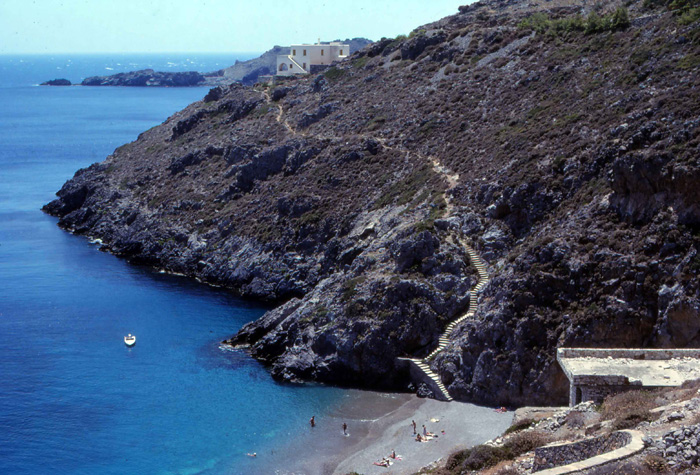
Kýthera, Greece's southernmost and least-visited Ionian island, is dotted with tiny beaches sheltered by cliffs.
Kýthera, more than any of its sister islands, was perpetually overrun
by conquerors, from Phoenicians and Spartans to Romans and Venetians,
each leaving a distinct imprint. Today the island population is much depleted,
something we notice immediately as our taxi heads to the capital -- whitewashed
Hora with iconic blue doors and shutters. Nearby, deep bays shelter secluded
beaches framed by rugged cliffs. We check into a small hotel and set out
for a walk. Where are all the people, I wonder, but then I had read that
some 60,000 Kytherians had immigrated to Australia decades earlier "Wow,
we sure are off the beaten track," my husband comments as we pass
by a few shops and cafés with only a handful of locals and no visible
tourists. A taxi takes us out to Mylopótamos, a medieval village
known for its 22 watermills and a ruined Venetian castle that is illuminated
at night. We stroll through its nearly deserted lanes. Later, at Kaládi
Beach, even warm golden sands cannot assuage our disappointment. There
is a definite sadness to the place, I conclude. We're missing the energy
of bustling island life. "Let's check the boat schedule," my
husband finally suggests. "Maybe we can move on to Crete." Sure
enough, there is a late morning boat leaving tomorrow from Diakoftí,
Kýthera's southern port, for Kissamós, near Haniá.
Later, drifting off to sleep, I recall how much we had admired Botticelli's
famous painting of Aphrodite on a visit to the Uffizi in Florence. The
goddess arrives in Kýthera on a seashell, striving to cover her
nakedness with her long golden hair!
The breeze
is bracing as we cross the Cretan Sea toward Kissamós. "Wow,
I've forgotten how enormous Crete is," I remark, clutching the railing
on the windy top deck. "I believe it's the fifth largest island in
the Mediterranean," my husband replies, "Like a country all
its own." When we called Alex hours earlier he was tickled that we
were actually coming to visit. "You should arrive by mid-afternoon,"
he chirped. "By the way, Panos is already here, and Martha and her
mother will be showing up tomorrow." Alex insisted that, above all,
we should plan to hike the Samarian Gorge together, promising to also
take us to a village celebration and on a side trip to Réthymnon.
"I also want to bring you to my favorite taverna in town where the
locals like to dance!" He can barely contain his excitement: "Imagine
four members of our Philadelphia dance troupe all under one roof in Crete.
How wonderful is that!"
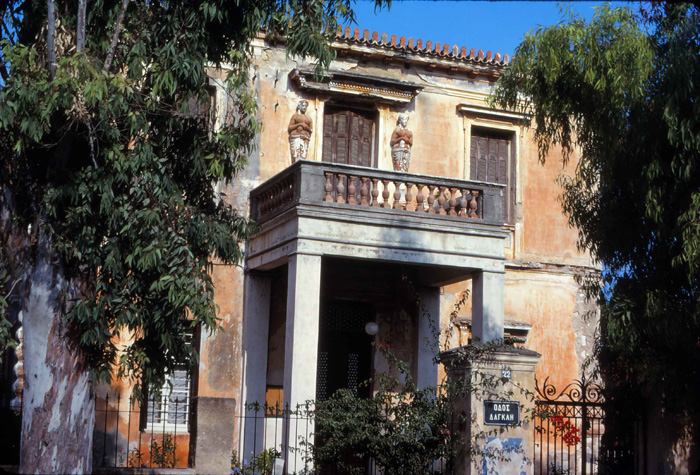
Halépa, a suburb of Haniá, is distinguished by time-worn Neoclassic mansions.
"Not much seems to have changed," I remark, recalling our last
visit to Haniá. Our taxi winds through Halépa and pulls
up in front of the house. Alex and Panos rush out to greet us, tiny glasses
of chilled ouzo awaiting on a tray. "In Petra some of us had to sleep
on the floor," Alex chuckles, "but here each guest has his own
bed! After you get settled, let's take a walk together in the neighborhood."
On our taxi ride earlier, I noticed that Halépa is quite gentrified,
with many neoclassic mansions dating from Greece's golden era. Steps away
from Alex's house is the elegant home of Eleftherios Venizelos, twice
prime minister of Greece.
The son of
an aristocratic Cretan family, Venizelos lived in the house during two
different periods. Now a museum, the house was tastefully furnished by
his wife, Helena, whom he married in 1921. Inside, we pause at a dozen
stations that highlight different periods in the statesman's life. He
is considered a national hero, one who helped sever the Ottoman yoke on
Crete and later to liberate Macedonia, Epirus and most of the Aegean,
resulting in the doubling of Greece's land area and population. In subsequent
years, Venizelos was pressured to dissolve the Greek monarchy, but could
not agree to the formation of a Greek Republic. "He abruptly left
Greece and died in exile in Paris." Alex notes. "Many regard
him as the most influential Greek of modern times."
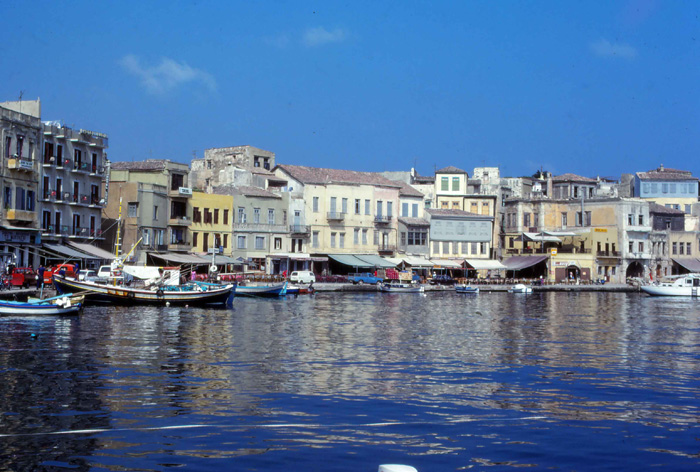
An expansive harbor dates back to Haniá's Venetian era.
By nine o'clock Haniá's Venetian port area is beginning to throng. Harbor lights twinkle in the Cretan night as noisy tourists pile into crowded tavernas and bars, and the scent of just-fried fish wafts out of windows and doorways. We're seated at a small table in a tiny, out-of-the-way taverna that features live music and where we are the only tourists. "This is the real deal," says Alex. "These two Cretan musicians are superb. The lýra player studied with Mountakis [a world famous Cretan musician] at one time, and the laoúto player is no slouch either." They are warming up for the evening, soon breaking into a traditional rizítiko. It's the first time I have heard this type of song live and it hearkens back to an earlier era when many Cretans eked out a hardscrabble existence in mountain villages. Rizítika are highly improvisational musical moments that convey the "soul" of the people. The mood is set, but the patrons want to dance. The musicians are happy to oblige, beginning with a siganós, followed by a lively haniótikos, the popular local dance, and finally ending with a pentozális. The latter dance builds in intensity as several men break into a vigorous display of kicks and leaps. While I have danced these Cretan dances many times, watching the locals let loose on the crowded floor is immensely satisfying.
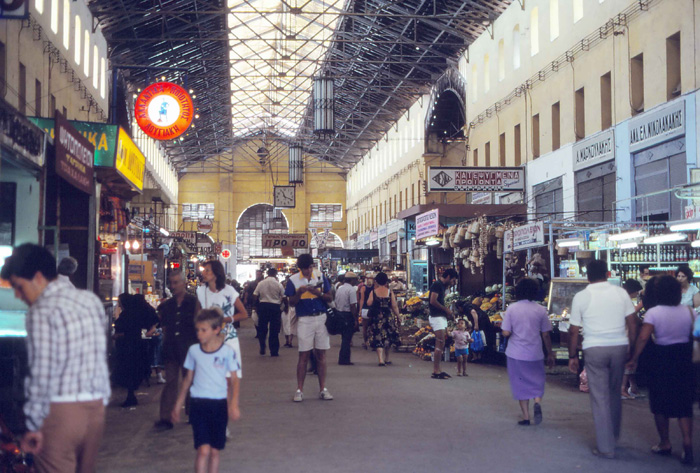
Hania's popular food hall ranks among Europe's finest, even rivaling La Boqueria in Barcelona.
In the cool of morning we return to the old town, anxious to visit the "Agorá," Haniá's famous covered food market, before it gets overcrowded. This cross-shaped hall dates back to 1913 when it was inaugurated by Venizelos as part of the island's reunification with Greece. Modeled after the famous market in Marseilles, it is chock full of all the finest products that Crete has to offer and ranks as one of the best food halls in Europe, even rivaling Budapest's Great Market and La Boqueria in Barcelona. There are at least 70 shops and cafés, grouped according to their specialties. Artful displays of Crete's famous foods beckon: olive oil, artisanal cheeses, mounds of aromatic herbs, thyme honey, choice cuts of local meat, and fish just delivered by pre-dawn boats. "Are you hungry yet?" asks my husband as he zeroes in on a café specializing in Cretan bougátsa, our very favorite morning pastry filled with local myzíthra cheese and sprinkled with powdered sugar and cinnamon. "Wow, this bougátsa is just incredible," I sigh, enshrining it in my culinary memory forevermore.
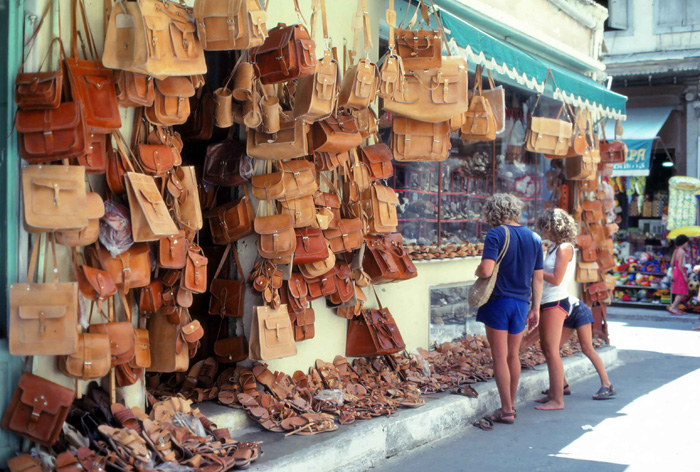
Jam-packed leather shops were once Crete's premier bootmakers.
Hania's historic district is adapting to modern tourism. On a narrow lane
near the harbor, crowded leather shops, known as stivanádika, are
doing a brisk business. In bygone days they were workshops that turned
out the exquisite, hand-made boots worn by all Cretan males. Today, since
manufactured shoes have virtually replaced boots, shops have shifted gears,
offering patrons a large variety of handbags, briefcases, wallets, belts,
and sandals. Many are factory-made, but still guaranteed to last for years.
The old town is abuzz with building activity. Several weathered Venetian
mansions are being converted into small hotels. A sign in front of a small
building under scaffolding on Halidon Street announces that a folk museum
will soon house displays of the bygone crafts of the Cretan people. On
Vouloukaki Street, Haniá's crumbling Romaniote synagogue, Etz Hayyim,
once the pride of the local Jewish community, also begs restoration. "This
would be an appropriate project for Nikos Stavroulakis to undertake,"
I suggest to my husband. "After all, his Greek Orthodox father was
born in Haniá, his mother was Jewish, and he created the Jewish
Museum in Athens. He is one amazing man: historian, archaeologist, fine
artist, creative cook, and the author of several books." "Is
there anything he cannot do?" my husband asks.
When we return
to Alex's house, we find him and Panos chatting and laughing with Martha
and her mother, Evelyn, who arrived a few hours earlier. "Well, tomorrow
is our day to hike through the Samarian gorge, but we'll need to get a
very early start. I think we should all go to bed early," Alex advises.
But sleep eludes me, and I toss and turn until four a.m. in anticipation.
Wearing sturdy walking shoes and dressed in layers, we arrive at Haniá's
central terminal in time to catch the six a.m. bus. Daybreak brightens
the sky as we climb toward the Plain of Omalós, a vast, barren
plateau. Beyond, Crete's White Mountains, the Lefká Óri,
are partly shrouded in morning clouds. The massive limestone mountain
range dominates western Crete, comprising about 30 peaks, the tallest
soaring over 8,000 feet.

The descent into the Samarian Gorge begins with a steep path
edged by a wooden railing dating from Ottoman times.
The world famous Samarian Gorge, the second longest chasm in all of Europe, begins its descent at the edge of the plateau. We are standing under the mammoth shadow of Mt. Gígilos which can be approached from an adjoining uphill trail. Not even a choice, I think, we're here for the gorge. "Peráste (you may pass), but do not lose your ticket," says the attendant in front of a wooden railing dating from Ottoman times. "Please read the sign near the entrance," Alex advises. "Our starting altitude is 4,035 feet, but eventually we will end up at sea level. Be extra careful as you proceed." He isn't kidding. The railing zigzags precipitously toward a viewing platform from which a very steep, stony switchback descends to the bottom of the gorge. At that point it is almost level and the rest of the hike becomes less demanding. The entire journey is about 13 kilometers long, plus another two kilometers to the village of Agía Roúmeli. Just beyond the village lies the azure Libyan Sea, fringed by a pebble beach. Here regularly scheduled ferries are available to shuttle hikers to Hora Sfakión where they can catch a return bus to Haniá.
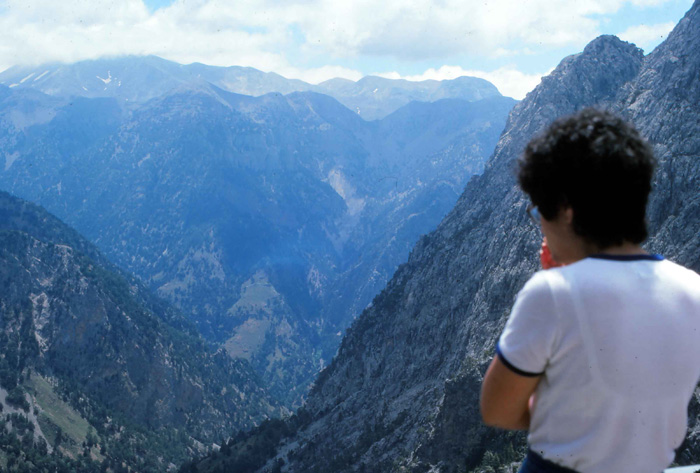
A viewing platform provides a dramatic vista of the gorge, the second longest in Europe.
"This is going to be one amazing day," I tell my husband. We take our time on the switchback trail, stopping frequently to gape at the evolving landscape with each change of direction, always minding our steps and dodging loose stones. At every angle, the views are breathtaking. The gorge was carved throughout the millennia by a swift-moving river that drained melting snow from the mountains, eventually becoming an abyss that plunges over 3,000 feet. The canyon is well sheltered and its remoteness makes it a haven for rare flora and fauna. My brochure notes that there are some 172 species of plant life in the gorge and more than a dozen rare species of animals, most notably the wild Cretan ibex known as kri-kri. "Will we see any on our hike?" I ask Alex who is first in line. "Most probably not," he answers, "but you can be sure they are watching us, hiding in their secret high spots. You might, however, be able to spot one of Crete's rare golden eagles, or even a bearded vulture." I am totally taken in by the diverse plant life surrounding us. Here and there clusters of purple and white anemones pop out of bushes of prickly juniper. Tucked among low lying ferns are stinky, scary-looking dragon flowers that resemble predatory insects. As you would expect, Greece's aromatic herbs grow here in abundance: wild thyme, marjoram, savory and yellow mountain sage, among others. The variety of trees is also impressive. Enormous cedars tower over oaks, pines, myrtles, carobs and gnarled old olive trees that still bear fruit. The breadth and depth of the gorge also serves as an incubator for plant species found nowhere else on earth. "Visiting botanists must go berserk here," I tease Martha and Evelyn who are stopping to sniff each new flower they encounter.
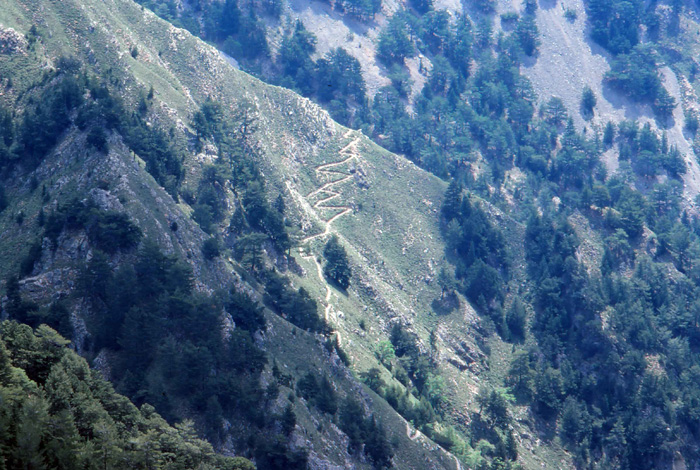
A zigzag trail plunges precipitously to the bottom of the gorge, home to flora and fauna found nowhere else in the world.
We finally hit bottom where a small spring can be easily crisscrossed from rock to rock. In springtime, when melting snows swell the stream, it becomes a dangerous torrent and the park is closed to the public. At Agios Nikolaos, named after a tiny, stone-roofed church, we find some facilities and a couple of nice flat rocks where we can sit and eat our sandwiches. Glinting behind a bush are a few chiseled stones, remnants of an ancient temple dedicated to Apollo. Four kilometers farther, the abandoned village of Samariá dates from the Byzantine period. The name Samariá derives from its famous convent, Ossia Maria, built in honor of the Blessed Mary of Egypt. Here two springs merge and we are happy to refill our water bottles. Apparently this part of the gorge had been continuously inhabited by loggers since the mists of time. The gorge also served as refuge for Cretan freedom fighters, who would retreat to secret hideouts whenever the Turks staged a raid. When the park was created in 1962, all the local people were forced to relocate. We pass by several derelict houses and tiny chapels. At the far edge of the village, Alex spots a baby kri-kri, most likely accustomed to tourists, but still unwilling to come forward. At long last, we approach the dramatic end of the gorge and its narrowest section known as "Iron Gates." Here, sheer canyon walls are only 13 feet apart but soar nearly 1000 feet overhead. "It's not the Grand Canyon, but it's very impressive," says my husband, appreciating the sheer drama of the site. Minutes later, a park attendant emerges from a hidden kiosk to collect our tickets. "They are required to account for every single ticket," says Alex. "That's how they make sure no one has been left behind after dark."
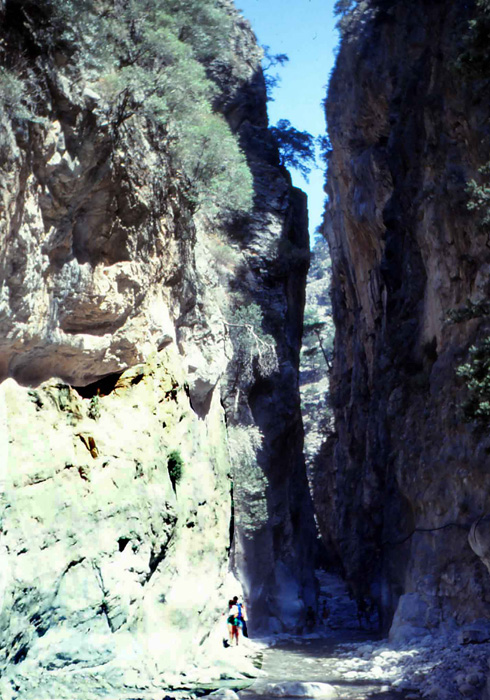
Iron Gates" provides a dramatic finale to the gorge. Here walls are only 13 feet apart but soar 1000 feet overhead.
The two remaining kilometers to Agía Roúmeli are no sweat.
This ancient outpost predates Homer and was once a thriving Minoan settlement.
During Caesar's time, it became a strategic stop on the trade route to
Egypt. In 1867, the village was completely destroyed by the Turks hours
after its residents had fled to secret hideouts in the gorge. Today it
exists to service hikers and nature lovers who come from every corner
of the world. We stop for a well-deserved rest at a crowded café
and order cold beers. An hour or so later, on the small ferry to Hora
Sfakión, we are rewarded with a brief but delightful journey on
the Libyan Sea. "Folks, the coast of Africa is only 730 miles from
here," Alex motions to the south from the top deck. "And about
26 nautical miles from here lie the islands of Gávdos and Gavdopoúla,
the southernmost land masses of Europe. As you would expect, they are
very popular with fishermen, campers and especially nudists!"
Hora Sfakión's harbor is bustling with activity as we pull in. Tired as we are we can't resist a visit. The local people, the Sfakianoí, make their living by shuttling tourists around Crete's southern coast, fishing and farming, or operating seaside tavernas and hotels that cater to trekkers. What distinguishes them from other islanders is a reputation for bravery, loyalty and long memory. They share the latter quality with their fellow countrymen, the Maniátes of the southern Peloponnese, whose perpetual vendettas are as intense as the Sfakianoí love of their patrída (mother country)! The latter are also renowned for their songs, spirited dances and tsikoudiá, a locally-distilled version of rakí. In a cozy taverna owned by one family for generations, we dive into a huge platter of sizzling octopus and kalamária. "Nóstimo" (delicious), I proclaim, apparently loud enough to be heard by the next table. Seven men turn toward us and we lock eyes. They are eating with gusto and clinking glasses repeatedly. I notice that three of them are blond and blue-eyed, testimony to their Dorian ancestry going back 2,000 years. Two have traditional saríkia (fringed, black head scarves) dangling on their foreheads, and all are wearing black boots. While most of Crete is modernizing rapidly, the old ways in Sfakiá still endure. We can feel the energy in the room, and I have no doubt that music and dance will erupt momentarily and last until the wee hours, but we have a bus to catch!
Halépa
is shrouded in darkness when we arrive, its velvet sky twinkling with
stars we never see at home. I drop into bed exhausted but elated. The
gorge was everything we had expected and then some. We awake in time to
bid farewell to Martha and Evelyn who are headed back to Athens, promising
a Greek party at our house when we're all back in Philadelphia. "It's
going to be extra hot today," says Alex, "so I recommend that
we take the coastal road on our afternoon visit to Rethymnón. It
will be cooler."
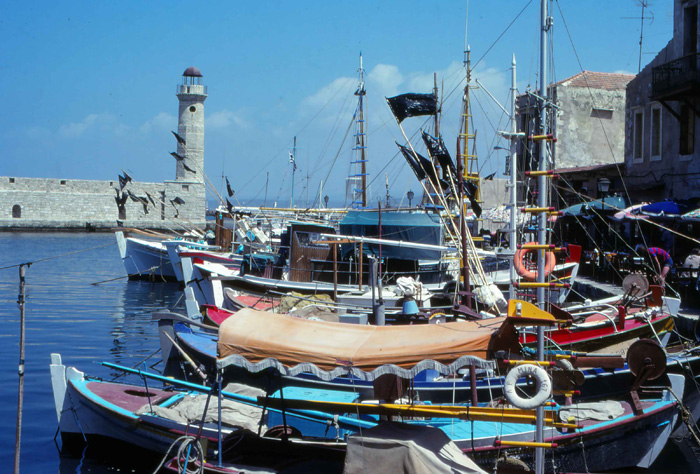
Rethymnon's compact Venetian harbor is packed with fishing boats.
We zoom past sandy beaches and roadside oleanders, finding ourselves at
Rethymnon's outskirts in no time. Strategically positioned midway between
Haniá and Iráklion, it is overlooked by Mount Psilorítis,
the second highest mountain in Crete and legendary birthplace of Zeus.
The city is world famous for its historic architecture and is a magnet
for tourists who flock to its annual July festival and special events.
There are vestiges of its Venetian and Ottoman eras in the old town where
narrow streets are lined with stately mansions and shops. When the Venetians
arrived in 1204 they built a sizable harbor which withstood the test of
time until the notorious pirate Barbarossa attacked. Today's compact harbor
is packed with fishing boats and surrounded by tavernas. We park near
the old town and stroll leisurely on its cobbled lanes. Overlooking the
scene is an evocative 16th century citadel shaped like a star and known
as Fortezza. Nearby, the 17th century Raimondi Fountain features three
stone lions whose mouths serve as spigots for fresh, drinkable water.
There are also several remnants from the Turkish era such as the domed
Neratze Mosque, built over the site of an old convent. Its tall minaret
still stands, but is too unstable to be scaled. At a small tailor shop
famed for traditional needlework, I purchase several Cretan costume pieces:
a short blue jacket elaborately embroidered with gold thread, a sártsa
skirt, a woolen waistband and an embroidered apron. Authentic pieces like
these are not available in the States, and both Alex and Panos make some
additions to their own dance costumes as well.
In early
evening, we head to a small village at the outskirts of Haniá where
a local celebration is about to take place. Greek filoxenía (hospitality)
always amazes me. Anyone who takes the trouble to come is invited to partake.
Long tables are laid out with bowls of barley rusks to be dipped in white
wine and locally pressed olive oil, platters heaped with mounds of graviéra
cheese, pots of tender stewed lamb and onions known as tsigouriastó,
and bowls of steaming gamopiláfo (Crete's version of risotto).
The food is Cretan cooking at its finest. We go back for seconds and I
wonder how and if I could replicate this feast back home. After several
musicians tune up, out comes a lineup of costumed children dancing their
hearts out, the boys leaping effortlessly into the air to the non-stop
cheers of adoring parents and all who have gathered. Inspired by the children,
the entire crowd forms a long line, joyfully moving to the music, us included.
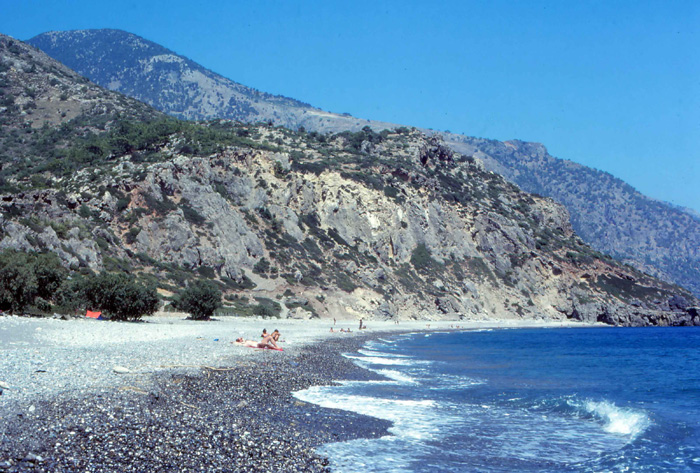
On Crete's less visited southern coast, Soúgia's idyllic pebble beach fringes the Libyan Sea.
Our final day in Crete is slated for decompression. Alex takes a winding road through the Lefká Óri heading south toward Soúgia, a sleepy town edging the Libyan Sea. It is only a short distance from Agía Roúmeli, but blissfully quiet without the endless hordes of hikers. Here, pebble beaches can be burning hot and one must wear protective sandals until reaching the water's edge. Nearby, narrow trails lead to less-visited canyons and gorges of the massive mountain range. We pretty much have the place all to ourselves and, after a couple of hours of frolicking in the sea, are ready to eat. At a beachside taverna we head straight to the kitchen to survey the day's offerings. A tray of moussaká has just come out of the oven. "Yum, that smells delicious," Panos remarks. "Excellent choice," we all agree. "Let's add a horiátiki salad to share and some Fix beers!"
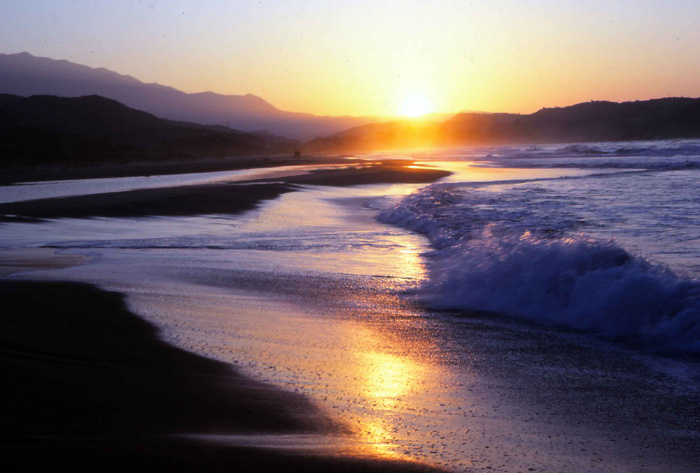
The sun plunges into the Aegean, streaking the sky in orange.
Back in Haniá, the sun is plunging into the Aegean, streaking the
sky in orange. Our time in Crete has come full circle and we pack ahead
for our noon flight to Athens. As a final gesture of filoxenía,
Alex surprises us with a breakfast of warm bougátsa and freshly
brewed coffee from his favorite neighborhood bakery. "You have really
outdone yourself!" I exclaim as we all hug goodbye. "See you
in Philadelphia and thank you so much for everything," we shout and
wave as our taxi pulls away. "Will we ever be able to surpass this
trip?" I ask my husband. "One day, maybe," he smiles. "But
right now it's at the very top of the list!"
